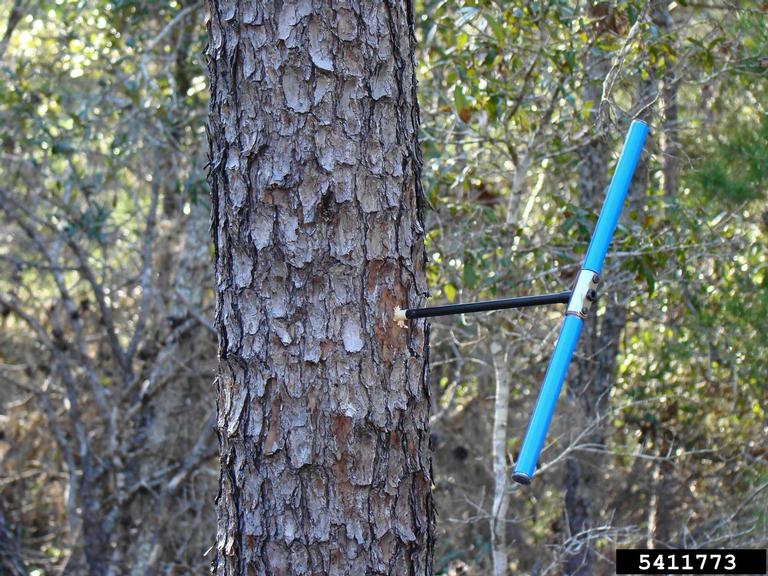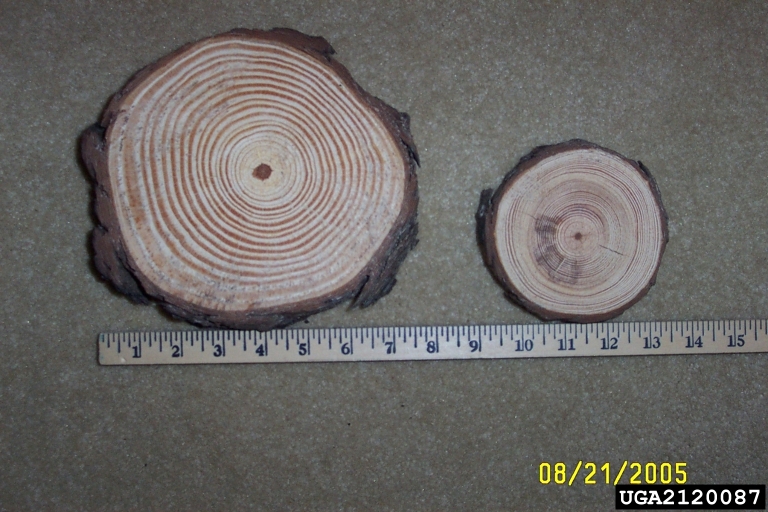 Wood Growth and Structure - October 18, 2017 Jeff Schalau, Agent, Agriculture & Natural Resources University of Arizona Cooperative Extension, Yavapai County Wood is produced by plants during the process of secondary growth. Woody plants include trees, shrubs, and vines. These plants have a unique architecture and a specialized meristematic tissue, called cambium, which produces wood. It’s very convenient that secondary growth occurs because humans utilize wood to create lumber, fuel, paper, and many other products. Wood is a true renewable resource and is important to many cultures worldwide. As mentioned above, the process of wood growth begins with the cambium. The cambium lies just beneath the wood and the inner bark which are also called the xylem and phloem. As the cambium grows, it produces new wood toward the inside and new phloem toward the outside causing the plant to increase in girth. To review, xylem transports sap (water and mineral nutrients) from the soil upward to the leaves where it can be used for photosynthesis and other processes. The phloem transports the products of photosynthesis downward bringing the sugars and other compounds to be used in the stem and roots. In looking closely at wood, it is composed of tiny, vertically oriented, straw-like cells. These cells are hollow providing pathways for the conduction of sap as well as support for the weight of the tree. In hardwoods (broadleaf plants), there are also radially oriented cells called “rays”. Rays move nutrients between the straw-like cells and store other compounds. Rays also give many hardwoods their unique appearance as is the case with “quarter sawn” oak. If this isn’t already complicated enough, coniferous trees do not have ray cells, but have resin ducts that contain the “pitch”. I have provided additional resources including images with the online edition that should help you visualize these abstract concepts. During the annual cycle of tree growth, the straw-like cells grow fast in the spring giving them larger diameters and these growth areas are called “early wood”. As the summer sets in and growth slows, the straw-like cells become smaller and denser and are called “late wood”. The next spring starts with early wood followed by late wood. Each year, this process is repeated. This annual growth pattern is what creates the annual rings we observe in wood when we look at the end grain. This is how we age trees, shrubs, and vines. Foresters sample trees for age using an increment borer and count rings to determine a tree’s age. As a tree gets older, it still produces new wood on the outer surface, but the older wood toward the center of the tree becomes darker. This is especially evident on woods such as juniper and walnut. The light colored, outer wood is called “sapwood” the darker, inner wood is called “heartwood”. Heartwood becomes darker because the cells are filled with rot resistant compounds that help the tree support itself and not succumb to rot-causing diseases. Humans take advantage of this phenomenon by seeking rot resistant woods for fence posts, decks, and other situations where durability is desired. This brief article is a simple overview of woody plant growth. Understanding it will help you become a better wood worker, arborist, firewood cutter, and more. The next time you look at a piece of furniture or a violin, you should have a greater appreciation of the craftsmanship. The next time you purchase firewood, you will be better informed as low density woods and rot can significantly decrease its energy output. More importantly, the next time you prune a woody plant or weed eat around a tree, you will better understand the impacts of your actions. When I studied forestry, I took a wood technology class. We informally called it “sniff and whittle” because we needed to identify over 60 different woods by using a hand lens, sharp knife, and sometimes our noses to pick up aromatic compounds. The book we used was called Understanding Wood, by R. Bruce Hoadley. I still use this book from time to time to assist Extension clientele with wood identification. If this topic interests you, be sure to see additional resources below. Follow the Backyard Gardener on Twitter – use the link on the BYG website. If you have other gardening questions, call the Master Gardener help line in the Camp Verde office at 928-554-8992 or e-mail us at verdevalleymg@gmail.com and be sure to include your name, address and phone number. Find past Backyard Gardener columns or provide feedback at the Backyard Gardener web site: http://cals.arizona.edu/yavapai/anr/hort/byg/. Photos  Increment borer used to age trees by foresters and other tree professionals (Rebekah D. Wallace, University of Georgia, Bugwood.org).
Increment borer used to age trees by foresters and other tree professionals (Rebekah D. Wallace, University of Georgia, Bugwood.org). Natural longleaf pines felled in an ice storm, Jan. 2005, in Randolph County, AL. Large cross-section was an open-grown tree with 20 annual rings. Small cross-section grew suppressed (competing with neighboring trees) with 43 annual rings. (David Stephens, Bugwood.org).
Natural longleaf pines felled in an ice storm, Jan. 2005, in Randolph County, AL. Large cross-section was an open-grown tree with 20 annual rings. Small cross-section grew suppressed (competing with neighboring trees) with 43 annual rings. (David Stephens, Bugwood.org).Additional Resources Wood Wikipedia en.wikipedia.org/wiki/Wood Shade and Street Tree Care UGA Extension extension.uga.edu/publications/detail.html?number=B1031 Introduction to Wood Structure and Characteristics University of Kentucky Cooperative Extension Service uknowledge.uky.edu/cgi/viewcontent.cgi?article=1104&context=anr_reports |